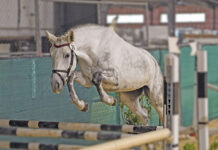Q.
My 5-year-old gelding has a nice carriage and collected walk, but loses most of it when we trot. At the canter, his stride is long and can become strung out. How can I help him collect and round up at the trot and canter without getting heavy on the forehand?
A.
It may seem better to first ask for collection at the walk, but this is the last gait to use for teaching collection. The walk has no phase of suspension, whereas the trot and canter do. If you ask for collection at the walk and the horse isn’t physically or mentally ready, he will stiffen his back, which affects his whole way of going. Once a walk is ruined, it is very difficult to correct. Therefore, ride the walk on a longer rein for a while, only asking for relaxation and a steady rhythm.
Collection is the culmination of training. There are many things to work on before worrying about collection. The horse must understand how to accept the bit and bring his weight off his forehand first.
The 20-meter circle is a great place to start because the slight bend of the circle will automatically encourage the horse to bear more weight on his haunches. Pick up a trot and ride a circle that begins and ends at the same place. If you don’t have a dressage arena, you can set out cones or buckets to create boundaries and focal points. Keep a steady tempo (speed) and consistent contact, and continue to trot around your circle. If all is well, add some downward transitions to the walk, using the half-halt: close your hand, close your lower leg, tighten your back muscles and sit a little heavier in the saddle. This aid should only last a stride, but repeat if needed. Take a few steps at the walk and then move back to the trot again, repeating the transitions.
If all goes well, ask for another downward transition, but this time, before your horse comes to the walk, change your mind and ask for the trot. This is a rebalancing technique to use when your horse begins to feel heavy on the forehand.
If your horse becomes so heavy that he won’t respond to this rebalancing aid, come to the halt, wait a moment, and then go back on the circle, repeating the transitions to refresh his memory. Next time, try to anticipate and apply the half-halt before your horse falls on the forehand.
Expert: Sharon Biggs is a frequent contributor to Horse Illustrated and a dressage instructor. She is the author of In One Arena (Half Halt Press) and the soon-to-be-released Advanced English Horsemanship (BowTie Press).
Get more advice from the experts >>






thnks for the info
Hi I have a 12 year old that has done western all his life. And I bought him like maybe a month ago and he is learning english because i hate western :]. Anyways he crowhops and bucks when he see’s a horse in the pasture and tries to run me into the fence at a gallop and he isn’t a stud. What should i do? I do not wear spurs or use a crop. And im a strong 13yearold that can handle anything that a horse does but he pulls when i tell him to go a certain way and throws a HUGE fit
how do i collect/extend gaits in the first place? all my books are sooooo vague.
Get collected is a very informational article. I use a hackamore on my horse so getting collected is a little harder than with a bit.
Get collected is such a helpful article! I tried a few of the tips with my horse and we had nice results! I had my trainer read this and she was impressed with it! She has been using advice from this article for lessons and so many people have had nice results!
I hope this helps! I’ve been trying to get my mare collected, but since we haven’t done English in years maybe she’s being lazy. Now, she just likes going very fast!
do not agree walk work can fix any canter problem and teach the horse to lighten the front end with the proper series of movements for that horse
Half halts help the horse to be more responsive and less on the bit. Canter/trot then half halt and begin the canter/trot again. The horse learns to be paying attention to you and is ready expecting another change.
Good article, thanks.